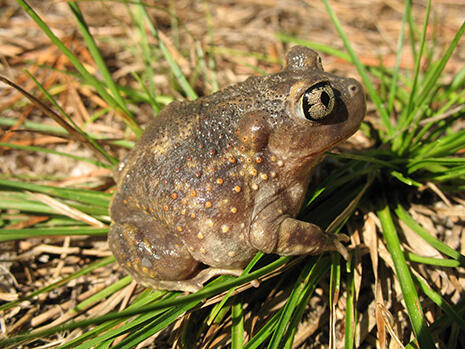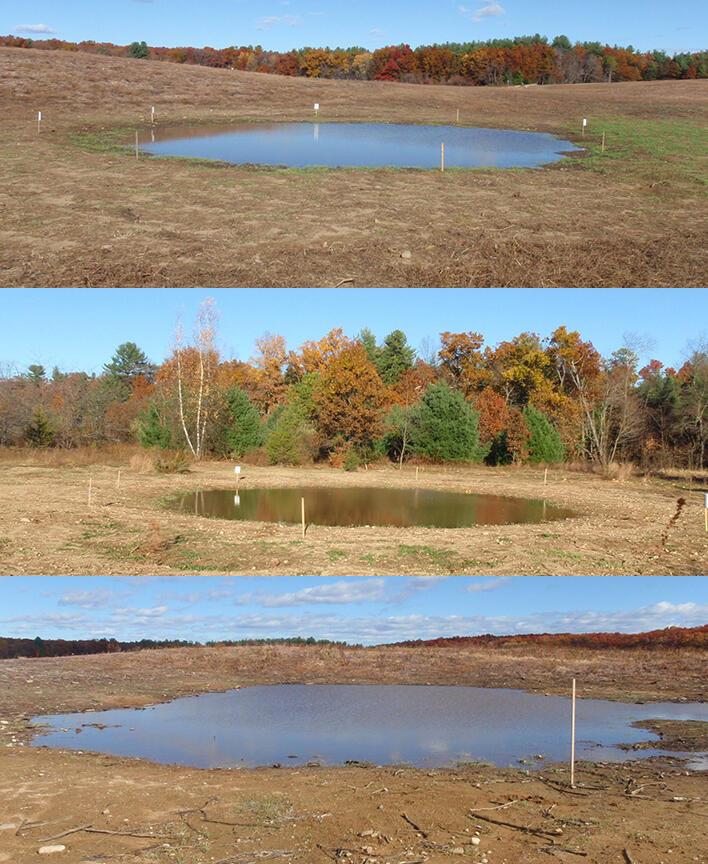Eastern spadefoot is listed as Threatened in Massachusetts. We are at the northern limit of the geographic range of the species, where populations are restricted mainly to Cape Cod. Isolated populations occur in the South Coast region, on Plum Island, on Martha’s Vineyard and Nantucket, and in the Connecticut River Valley region. Conservation priorities for Eastern Spadefoot in those regions include population inventory and monitoring, land protection, habitat management, and—where appropriate—population management.
Management for eastern spadefoot in the Connecticut River Valley has become an especially high priority. The regional population appears to be in decline, as 2 of 6 local populations known from the area are presumed to have been extirpated during the past century, and 3 others have not been documented in over a decade. Persistence of the region’s spadefoot populations is challenged by habitat degradation, and most inferred habitat is vulnerable to fragmentation or loss. Where land protection for the species is impractical or infeasible, population establishment via translocations to already-protected sites is a possible management tool.
The Southwick WMA occurs within the historic range of eastern spadefoot and is only 5 miles away from the nearest documented population. The site has a sandy soil base, is being maintained in an open condition, and will contain grassland-shrubland, grassland-woodland, and shrubland-woodland edges over the long term, thus providing suitable terrestrial habitat for eastern spadefoot. The only habitat feature lacking at the site is water—namely, ephemeral pools, which are essential for the species to reproduce.
Funding provided by the Massachusetts Outdoor Heritage Foundation and its partnership with Genzyme, a Sanolfi company, has given us a golden opportunity to take direct management action for the benefit of eastern spadefoot. Pooling those funds with our own resources and in-kind contributions from partners, we have initiated a project to establish a new population of eastern spadefoot at the Southwick WMA. If successful, the project will substantially improve the long-term security of Eastern Spadefoot in the Connecticut River Valley region and contribute new knowledge about the effectiveness of certain management techniques. The project is also expected to increase general wildlife diversity at the Southwick WMA by providing breeding habitat for American toad (Anaxyrus americanus) and/or Fowler’s toad (Anaxyrus fowleri), temporary foraging/stopover habitat for other amphibian species (e.g., pickerel frog [Lithobates palustris], gray treefrog [Hyla versicolor]), and both drinking water and foraging habitat for a variety of birds and mammals.
Objectives
- Establish prospective breeding habitat for eastern spadefoot at the Southwick WMA by constructing a series of ephemeral-pool basins.
- Introduce eastern spadefoot to the Southwick WMA over a period of several years or more via:
- direct translocations of eggs and/or tadpoles from other sites to the constructed pools; and
- delayed translocation of “head-started” tadpoles and juveniles to the constructed pools.
- Monitor the Southwick WMA regularly to determine:
- survival of eggs/tadpoles in constructed pools;
- presence of metamorphs, juveniles, and adults at the site; and
- occurrence of breeding activity.
- Periodically manage soil conditions along field-forest and field-shrub edges to maintain important terrestrial habitat (if necessary).
Progress & results
Three pool basins were constructed across northern portions of the WMA during August–September 2015. Construction work was performed by a team consisting of our staff from the Connecticut Valley District Office and the Westborough Field Headquarters, undergraduate students in Dr. John McDonald’s Wildlife Ecology and Management course at Westfield State University, and students in the Natural Resource Management program at Bristol County Agricultural High School (led by instructors Brian Bastarache and Aaron Caswell). The Southwick Department of Public Works provided essential equipment for executing design plans.
The basins were engineered with intent to hold standing water for periods of 3–6 weeks following heavy or prolonged rains in spring and summer. Two of the pools are expected to attain a maximum depth of 8 inches over a circular area 30 feet in diameter; one basin (“P1”) was constructed in a grassland setting, whereas the other (“P2”) was set in a shrubland. The third pool (“P3”) was constructed in a grassland and is expected to attain a maximum depth of 24 inches over an elliptical area 100 feet long by 50 feet wide. The basins were constructed with different materials and are expected to have variable rates of water loss. Construction of breeding habitat for eastern spadefoot is still an evolving practice, and so use of different pool designs (in different microhabitat settings) will add an experimental component to the project and simultaneously maximize the chances of at least one pool becoming a productive breeding site.
Next steps
The NHESP will be coordinating and/or implementing the following actions to meet project objectives during the coming years:
- Monitor basin hydrology of P1, P2, and P3 to determine pool hydroperiod under varying environmental conditions and evaluate suitability for implementing egg/tadpole translocations.
- Monitor known spadefoot breeding sites in the Connecticut River Valley and elsewhere to identify the most suitable donor populations for egg/tadpole translocations to the Southwick WMA, and to determine timing and intensity of egg/tadpole withdrawals.
- Implement egg/tadpole translocations and tadpole/juvenile head-starting program as soon as conditions allow. Conduct translocations annually (when possible) during 2016–2019.
- Survey the Southwick WMA periodically to determine survival of introduced eggs/tadpoles, use of constructed pools by other wildlife, presence of surviving spadefoots in the terrestrial environment, and (eventually) spadefoot breeding activity.
- If necessary (and feasible), selectively harrow field-shrubland and field-woodlot edges to maintain suitable topsoil conditions in critical areas.
- If feasible, construct 2–4 additional pool basins in southern and/or eastern portions of the Southwick WMA.
Adaptive management is an expected need, and close coordination with grassland bird management will be necessary. Hence, some aspects of the project may be adjusted slightly over time, as needs arise.
Contact
Online
Phone
Open M–F, 8 a.m.–4 p.m. (closed noon–12:30 for lunch)
North/Central/Western Massachusetts
Southeastern Massachusetts/Cape & Islands

